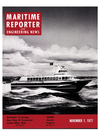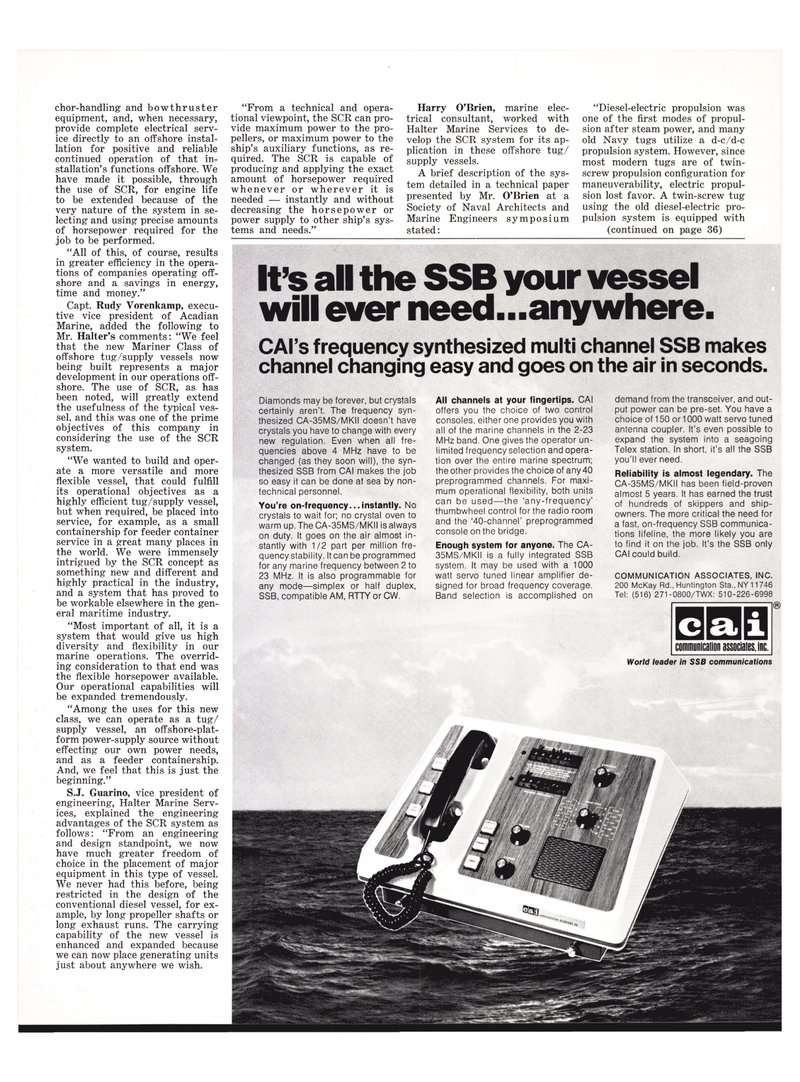
Page 35: of Maritime Reporter Magazine (November 1977)
Read this page in Pdf, Flash or Html5 edition of November 1977 Maritime Reporter Magazine
chor-handling and bowthruster equipment, and, when necessary, provide complete electrical serv- ice directly to an offshore instal- lation for positive and reliable continued operation of that in- stallation's functions offshore. We have made it possible, through the use of SCR, for engine life to be extended because of the very nature of the system in se- lecting and using precise amounts of horsepower required for the job to be performed. "All of this, of course, results in greater efficiency in the opera- tions of companies operating off- shore and a savings in energy, time and money."
Capt. Rudy Vorenkamp, execu- tive vice president of Acadian
Marine, added the following to
Mr. Halter's comments: "We feel that the new Mariner Class of offshore tug/supply vessels now being built represents a major development in our operations off- shore. The use of SCR, as has been noted, will greatly extend the usefulness of the typical ves- sel, and this was one of the prime objectives of this company in considering the use of the SCR system. "We wanted to build and oper- ate a more versatile and more flexible vessel, that could fulfill its operational objectives as a highly efficient tug/supply vessel, but when required, be placed into service, for example, as a small containership for feeder container service in a great many places in the world. We were immensely intrigued by the SCR concept as something new and different and highly practical in the industry, and a system that has proved to be workable elsewhere in the gen- eral maritime industry. "Most important of all, it is a system that would give us high diversity and flexibility in our marine operations. The overrid- ing consideration to that end was the flexible horsepower available.
Our operational capabilities will be expanded tremendously. "Among the uses for this new class, we can operate as a tug/ supply vessel, an offshore-plat- form power-supply source without effecting our own power needs, and as a feeder containership.
And, we feel that this is just the beginning."
S.J. Guarino, vice president of engineering, Halter Marine Serv- ices, explained the engineering advantages of the SCR system as follows: "From an engineering and design standpoint, we now have much greater freedom of choice in the placement of major equipment in this type of vessel.
We never had this before, being restricted in the design of the conventional diesel vessel, for ex- ample, by long propeller shafts or long exhaust runs. The carrying capability of the new vessel is enhanced and expanded because we can now place generating units just about anywhere we wish. "From a technical and opera- tional viewpoint, the SCR can pro- vide maximum power to the pro- pellers, or maximum power to the ship's auxiliary functions, as re- quired. The SCR is capable of producing and applying the exact amount of horsepower required whenever or wherever it is needed — instantly and without decreasing the horsepower or power supply to other ship's sys- tems and needs."
Harry O'Brien, marine elec- trical consultant, worked with
Halter Marine Services to de- velop the SCR system for its ap- plication in these offshore tug/ supply vessels.
A brief description of the sys- tem detailed in a technical paper presented by Mr. O'Brien at a
Society of Naval Architects and
Marine Engineers symposium stated: "Diesel-electric propulsion was one of the first modes of propul- sion after steam power, and many old Navy tugs utilize a d-c/d-c propulsion system. However, since most modern tugs are of twin- screw propulsion configuration for maneuverability, electric propul- sion lost favor. A twin-screw tug using the old diesel-electric pro- pulsion system is equipped with (continued on page 36)
It's all the SSB your vessel will ever need.-.anywhere.
CAI's frequency synthesized multi channel SSB makes channel changing easy and goes on the air in seconds.
Diamonds may be forever, but crystals certainly aren't. The frequency syn- thesized CA-35MS/MKII doesn't have crystals you have to change with every new regulation. Even when all fre- quencies above 4 MHz have to be changed (as they soon will), the syn- thesized SSB from CAI makes the job so easy it can be done at sea by non- technical personnel.
You're on-frequency...instantly. No crystals to wait for; no crystal oven to warm up. The CA-35MS/MKII is always on duty. It goes on the air almost in- stantly with 1/2 part per million fre- quency stability. Itcanbe programmed for any marine frequency between 2 to 23 MHz. It is also programmable for any mode—simplex or half duplex,
SSB, compatible AM, RTTY or CW.
All channels at your fingertips. CAI offers you the choice of two control consoles, either one provides you with all of the marine channels in the 2-23
MHz band. One gives the operator un- limited frequency selection and opera- tion over the entire marine spectrum; the other provides the choice of any 40 preprogrammed channels. For maxi- mum operational flexibility, both units can be used—-the 'any-frequency' thumbwheel control for the radio room and the '40-channel' preprogrammed console on the bridge.
Enough system for anyone. The CA- 35MS/MKII is a fully integrated SSB system. It may be used with a 1000 watt servo tuned linear amplifier de- signed for broad frequency coverage.
Band selection is accomplished on demand from the transceiver, and out- put power can be pre-set. You have a choice of 150 or 1000 watt servo tuned antenna coupler. It's even possible to expand the system into a seagoing
Telex station. In short, it's all the SSB you'll ever need.
Reliability is almost legendary. The
CA-35MS/MKII has been field-proven almost 5 years. It has earned the trust of hundreds of skippers and ship- owners. The more critical the need for a fast, on-frequency SSB communica- tions lifeline, the more likely you are to find it on the job. It's the SSB only
CAI could build.
COMMUNICATION ASSOCIATES, INC. 200 McKay Rd., Huntington Sta., NY 11746
Tel: (516) 271-0800/TWX: 510-226-6998 a. a communication associates, inc.
World leader in SSB communications

 34
34

 36
36
